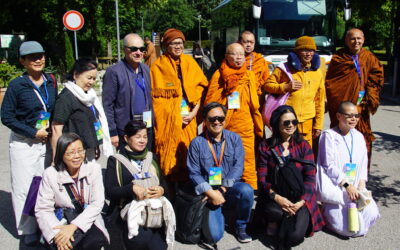 «The youth of today will be the leaders of the tomorrow. From the questions and often impetuous desires of young people, from their opinions and sometimes impatient and exaggerated demands, we can understand something of what is going on in the minds of people in any given epoch. Those who are very much in contact with today’s young people, come up against two tendencies which seem to be contradictory: on one hand young people want closeness, equality and spontaneity, so that whoever is distant or too high is neither accepted nor understood. They want people who have something to say, not to be too different from them but to have an inside-knowledge of their situation. In short, they don’t want these people to feel that they are above everyone else in some way, with their answers come down from somewhere on high. At the same time, however – and this is the other tendency – we discover in young people a great thirst for originality, the need for a model they can hold up in front of them, an Ideal they can follow which is convincing and a way of life. Young people want to draw their lives from depths they themselves are not able to reach, from a source they feel cut off from. They are looking for someone who is very close to them and at the same time someone “who comes from the land of distant waters” to make them drink. They are looking for someone who is both like them and at the same time completely different. They are looking for someone who is small and at the same time someone who possesses a greatness without which life is dull, frivolous and empty. In a sense broader than that of a specifically religious or Christian context, we could say: young people, indeed, humanity today, is attracted both by: action and a mystical dimension, nearness and authority, brotherhood and mandate. Couldn’t this be nostalgia for Jesus Christ? For the Son of God who comes to us as the Son of Mary, for the Messiah who belongs to the carpenter’s family? Yes. And this nostalgia for Jesus Christ is also a nostalgia for the priest: for that priest, whose message becomes credible by means of his personal life, and who gives witness to this message through his own experience, by what he says and what he brings, even though his ultimate authority comes from Jesus Christ Himself. The priest in himself is a man like any other; he must never elevate himself as if he were somehow higher or better. But it is also true that Jesus Christ has imprinted Himself upon the priest. Jesus chose the priest and sent him out to bring His presence near to men and women, to witness to Him and transmit His life, and message. There is something different in the priest, but this difference can be justified only because of Jesus Christ and for Him. Thus, courage is needed, courage to differentiate oneself and courage to be near; courage to live in contemplation and courage to serve with simplicity and humility; courage to climb Mt Tabor and courage to wash the feet of one’s neighbour: this is the figure of the priest today. And this figure meets the desire of our times, the nostalgia for Jesus Christ who comes from the Father in Heaven and at the same time, lives the everyday life of ordinary people. To live Christ, to live his mission, to live his authority close to Mary, the Handmaid of the Lord – this is what it means to be priests today. In a word: the priest, the response of God to our times; the priest – the man of our times […]». (To be continued) Klaus Hemmerle: The Priest Today (1) Forthcoming event
«The youth of today will be the leaders of the tomorrow. From the questions and often impetuous desires of young people, from their opinions and sometimes impatient and exaggerated demands, we can understand something of what is going on in the minds of people in any given epoch. Those who are very much in contact with today’s young people, come up against two tendencies which seem to be contradictory: on one hand young people want closeness, equality and spontaneity, so that whoever is distant or too high is neither accepted nor understood. They want people who have something to say, not to be too different from them but to have an inside-knowledge of their situation. In short, they don’t want these people to feel that they are above everyone else in some way, with their answers come down from somewhere on high. At the same time, however – and this is the other tendency – we discover in young people a great thirst for originality, the need for a model they can hold up in front of them, an Ideal they can follow which is convincing and a way of life. Young people want to draw their lives from depths they themselves are not able to reach, from a source they feel cut off from. They are looking for someone who is very close to them and at the same time someone “who comes from the land of distant waters” to make them drink. They are looking for someone who is both like them and at the same time completely different. They are looking for someone who is small and at the same time someone who possesses a greatness without which life is dull, frivolous and empty. In a sense broader than that of a specifically religious or Christian context, we could say: young people, indeed, humanity today, is attracted both by: action and a mystical dimension, nearness and authority, brotherhood and mandate. Couldn’t this be nostalgia for Jesus Christ? For the Son of God who comes to us as the Son of Mary, for the Messiah who belongs to the carpenter’s family? Yes. And this nostalgia for Jesus Christ is also a nostalgia for the priest: for that priest, whose message becomes credible by means of his personal life, and who gives witness to this message through his own experience, by what he says and what he brings, even though his ultimate authority comes from Jesus Christ Himself. The priest in himself is a man like any other; he must never elevate himself as if he were somehow higher or better. But it is also true that Jesus Christ has imprinted Himself upon the priest. Jesus chose the priest and sent him out to bring His presence near to men and women, to witness to Him and transmit His life, and message. There is something different in the priest, but this difference can be justified only because of Jesus Christ and for Him. Thus, courage is needed, courage to differentiate oneself and courage to be near; courage to live in contemplation and courage to serve with simplicity and humility; courage to climb Mt Tabor and courage to wash the feet of one’s neighbour: this is the figure of the priest today. And this figure meets the desire of our times, the nostalgia for Jesus Christ who comes from the Father in Heaven and at the same time, lives the everyday life of ordinary people. To live Christ, to live his mission, to live his authority close to Mary, the Handmaid of the Lord – this is what it means to be priests today. In a word: the priest, the response of God to our times; the priest – the man of our times […]». (To be continued) Klaus Hemmerle: The Priest Today (1) Forthcoming event
Be authentic
Be authentic




0 Comments